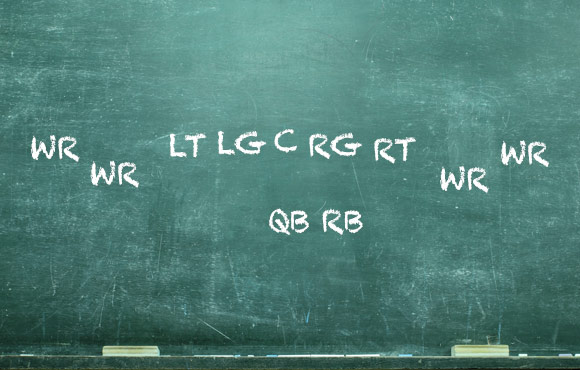Coaches have different philosophies on defensive formations, based on the players they have, what they're expecting out of the opposing offense and what they feel most comfortable with.
In most cases, it's one of seven different formations. Here's a breakdown of each one and why coaches may choose them come game day.
The 4-3
1 of 8
The 4-3 is the most commonly used defense at the upper levels, including the NFL. At lower levels the 4-3 is not particularly popular because many coaches consider it weak against the run due to the fact there are only four down linemen. At the higher levels, the quality and size of the average down linemen makes this a non-factor. In essence, if a team possesses the size, strength and quickness necessary to run the 4-3 defense, it is a formidable formation.
Besides the ever-present four down linemen (2 tackles and 2 ends), there are three linebackers—two to the inside and one at the outside shoulder of the tight end. Two cornerbacks and two safeties are the standard. Equally effective against most all offensive formations, the 4-3 is the default defense of choice for this author. It is easily modified for various offensive sets. The third linebacker (on the tight end) can cover the tight end, blitz or cover any of the short zones to that side or the hook zone over the middle. The cornerbacks can blitz with the safety(s) assuming the corner's responsibilities. Or a corner can drop back in deep coverage allowing a safety blitz.
Because of its high flexibility, an offense will find it difficult to isolate a particular area or defensive player. If the 4-3 has a weakness, it is that the inside linebackers are the primary tacklers for runs between the tackles and they are, of course, four to five yards off the ball.
The 3-4
2 of 8
The 3-4 is designed to stop the short passing, ball control offense. Naturally less than ideal against the run due to only three down linemen, this defense offers an extra defensive back for pass coverage.
Consisting of a nose guard and two other down linemen, the coach has the task of deciding who the outside two linemen will be—ends or tackles. Often one of the linebackers has zone pass coverage responsibilities, in effect employing five defensive backs. This is why the 3-4 is often referred to as the "nickel" defense. Having five defensive backs allows for random blitzing by one or more of these backs in order to maintain a sufficient pass rush. The 3-4 is susceptible to the inside run and is used primarily is situations where an interior run is not expected.
The 4-4
3 of 8
The 4-4 is designed to stop the wide running game as well as the short passing game.
The 4-4 uses four down linemen, four linebackers, two cornerbacks and a safety. Stunts are a common component of this defensive set, usually with some or all of the linemen stunting left or right and the inside linebackers stunting in the opposite direction. A wide range of possible stunts and blitzes are possible. The 4-4, also known as the "stack" defense, relies on quickness—particularly quickness in pursuit. In order to run the 4-4 on a regular basis, the interior down linemen must be players of considerable substance.
The 5-2
4 of 8
The 5-2 is the standard for many coaches at the high school level and is used somewhat extensively at the collegiate level. Consisting of a nose guard, two defensive tackles and two defensive ends, it is intended mainly as a run defense. However, it can be effective against the pass as well with five pass rushers and two or three linebackers.
Usually the down linemen's first responsibilities are running lane-specific, with each man responsible for a certain gap or lane. The default command for linemen is to read and react to the play, with the defensive end's primary concern being containment. Occasionally, a defensive end may be called on to pass defend an area such as the flat. By design, the linebacker's first responsibility is to defend the run, then the pass. But this may be modified for varying purposes. A coach wants his leading tacklers to be down linemen or linebackers. If a defensive back or safety is leading the team in tackles, it is a clear indication that the opposing offenses are getting through the first line of defense.
The remaining four positions are the two cornerbacks and the two safeties. An option is to allow one of the safeties to be a "free safety," meaning that this player seldom has specific duties and is left to read and react to each play. In zone pass coverage, the free safety or safety to the tight end side has "up" responsibility, while the strong safety has deep third duty. Each corner has deep third duty as well. Linebackers are four to five yards off the ball, cornerbacks three to six yards deep, safeties 10 to 12 yards. Down linemen keep the ball in the corner of the eye, and move on the snap—not the quarterback's vocalizations or other personnel movement.
The 5-3
5 of 8
The 5-3 is even more intent on stopping the run and is designed to make use of a strong middle line backer. Similar to the 5-2, the 5-3 simply replaces the free safety spot with a third linebacker, who lines up on the outside shoulder of the tight end, five yards deep and parallel with the other linebackers. The "best" linebacker moves to the middle linebacker position.
Obviously, modifications or shifts may be necessary depending on the actual alignment of the offense. For example, let's say the offense opened in a Tripps (three receiver) set to the defense's right. Basically, all that has happened is the fullback and left wide receiver have been replaced with two new wide outs to the right. So the left cornerback shifts over with the new receiver, and the left outside linebacker shifts over as well. The two remaining linebackers return to their normal 5-2 alignment.
Another variation calls for the three linebackers to all shift down to compensate. The tight end can be covered by the defensive end to that side or the linebacker to that side. The defensive end to the Tripps side can cover the flat or slat area, or even be sent on a blitz.
The 6-2
6 of 8
The 6-2 is the standard short yardage defensive formation. It is often implemented to stop the run.
Basically, the six down linemen are positioned in the gaps between the offensive linemen with the two inside linebackers playing run first, pass second. The cornerbacks and the safety (playing up tight to the line) play pass first, run second, each with deep third responsibilities.
The Goal Line Defense
7 of 8
The goal line defense is similar in appearance to the 6-2, but the responsibilities are different due to the proximity to the goal line. There is no tomorrow at the goal line. No need to worry about deep or even medium coverages.
The middle two linebackers stay back in order to meet the running back as he comes to the line, particularly if the back leaves his feet and dives for the end zone. The outer two linebackers (or cornerbacks) have the luxury of playing run first with containment responsibilities, leaving all six down linemen free to penetrate and drive into the offensive back field. If the offense passes the ball, the middle two linebackers (who remained back) fall back to the end zone in zone pass coverage occupying the middle, while the outside two linebackers retreat to cover the corners of the end zone. The safety reads the quarterback's eyes and plays the ball.







Discuss This Article